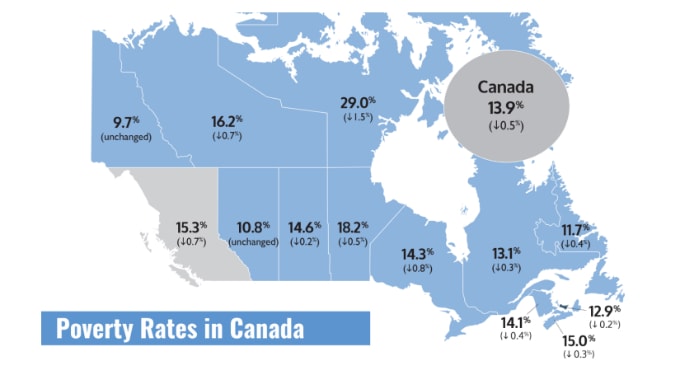KJIPUKTUK (Halifax) – Yet another national survey comparing provincial poverty rates was released today.
Whether it’s child poverty that is being measured, minimum wage, or the release of Statistics Canada census-based income data, somehow for Nova Scotia the news is always grim.
Poverty Trends 2017, a report published by Citizens for Public Justice, a national faith-based social justice group, is no exception.
Using the 2016 census data recently released by Stats Canada the report provides a national snapshot of poverty as of 2015.
At 15% Nova Scotia remains the province with the highest poverty rate in Atlantic Canada, although that number decreased by 0.3% compared to 2014.
Of all Canadian provinces only Manitoba and British Columbia have a higher poverty rate than Nova Scotia.
Halifax, with a poverty rate of 14.1%, sits in 9th place in a listing of 20 big cities with the highest poverty rates. CBRM is sixth out of the top 20 medium-size cities, with 19.4%. New Glasgow is in 16th place, with 16%, Kentville is in 18th place, with 15.6%.
Nova Scotia’s poverty rate of 15% is also considerably higher than the national average of 13.9%. That’s 4.8 million people, which translates into one in seven Canadians.
This may surprise you, but most adults living in poverty in Canada are employed. 70% of people living in poverty are working poor. 42.9% of single working-age adults live in poverty.
Of course, as always, the segments of the population most affected by poverty include people of colour, indigenous people, immigrants, people with disabilities, refugees, and children, especially children in single parent households.
See also: Where the poor people live. Stats Canada puts Nova Scotia’s poverty on the map.
If you can, please support the Nova Scotia Advocate so that it can continue to cover issues such as poverty, racism, exclusion, workers’ rights and the environment in Nova Scotia. A pay wall is not an option, since it would exclude many readers who don’t have any disposable income at all. We rely entirely on one-time donations and a tiny but mighty group of dedicated monthly sustainers.






Much needed study — confirms the worst
The math is wrong. The national average according to the figures on the map is 14.99%.
Only if every province had exactly the same population. However, more people live in Ontario than in PEI. The numbers come from Stats Canada, they know how to do math.